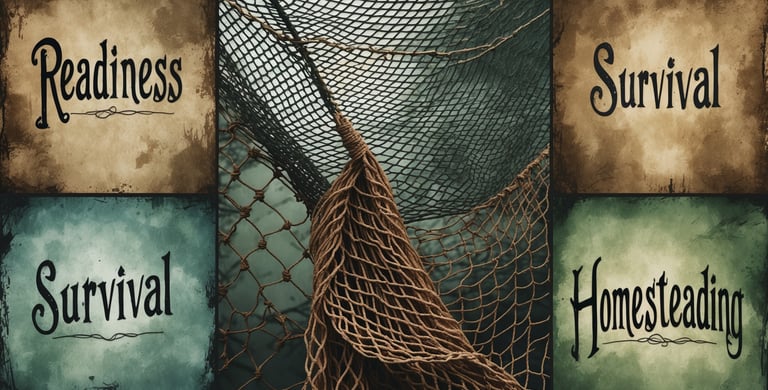Survival: Urban Survival
Enduring Chaos in Populated Collapse Zones
4FORTITUDER - READINESS, SURVIVAL, PREPAREDNESS, HOMESTEADING
Survival: Urban Survival
Enduring Chaos in Populated Collapse Zones
“The jungle kills with fang and claw. The city kills with silence and speed.”
— Urban Warfare Maxim
Concrete Isn’t Comfort in Collapse
Most men believe survival only applies in the wilderness. But history proves otherwise: the most dangerous survival environments are not remote forests—they are cities in collapse. Dense populations. Fractured logistics. Aggression, scarcity, confusion, and speed.
Urban survival is not about bushcraft. It’s about movement, anonymity, and clarity under pressure. You’re not hunting for food—you’re navigating human volatility, failing infrastructure, and hostile environments where help may never come.
When cities break, they do not dissolve slowly. They implode violently.
Core Knowledge Foundation: Understanding the Urban Threatscape
Urban collapse is a uniquely layered survival threat. You must train for:
Mobility – Getting out (or across) without relying on roads, GPS, or gas.
Concealment and Anonymity – Not being noticed is often safer than being equipped.
Scavenging and Resource Location – What to take, what to leave, and how to avoid bottlenecks.
Urban Defense and Escape – Securing shelter from break-ins, riots, and surveillance.
Misconception Warning: You cannot “out-strength” an urban collapse. You must out-think, out-move, and outlast.
Advanced Insights: The Urban Survival Sequence
Here’s how to think strategically, not reactively, when urban collapse begins.
1. Decision Point: Stay or Move?
Most casualties occur in the first 48 hours because people hesitate.
How to Decide:
Do I have a known safe zone outside the city?
Are roads still open? Can I move without attracting attention?
Are utilities down, law enforcement offline, and rumors escalating?
Rule: If you plan to leave, do so before it’s too late. If you stay, commit to defend and endure.
2. Movement: Avoid Main Roads and Hot Zones
How to Move:
Use side streets, alleys, overpasses, and drainage tunnels. Learn them in peace.
Travel during twilight or early dawn—not pitch black (when predators move) or daylight (when mobs gather).
Dress like a nobody. Dirty hoodie, backpack with worn patches. Gray Man rules: blend, don’t impress.
Drill: Walk 3 alternate routes from your home to your workplace without main roads or digital aid. Document water points, hiding spots, dangerous corners.
3. Shelter: Reinforce or Relocate
If you stay:
Reinforce with barricades that look accidental. Don't signal you have resources.
Use internal rooms for sleep. No windows. Soundproofing. Escape path ready.
If you move:
Abandoned buildings near medical or industrial zones are better than residential.
Avoid government buildings. They draw conflict and surveillance.
4. Scavenging: High-Value, Low-Risk
What to look for:
Water first: Office water coolers, toilet tanks (not bowls), rooftop barrels.
Medical: Under-the-counter kits in dental offices, gyms, cleaning closets.
Food: Vending machines, hotel kitchens, school cafeterias.
Avoid:
Grocery stores and pharmacies. These become war zones in hours.
Drill: Enter a public building (legally). Map 5 emergency items and 3 ways to escape. Do this weekly in different locations.
5. Human Contact: Trust Rarely, Communicate Clearly
Urban Rule: Every human is a variable. Desperation distorts morality.
Avoid groups unless already bonded and pre-trained.
Speak in task-focused language: “I need to go,” not “I’m scared.”
Carry barterable items: batteries, water, hygiene kits, socks.
Critical Perspectives: The Myth of the Lone Wolf or Savior State
Adversarial Viewpoint:
“Urban collapse is a fantasy. Law enforcement will always restore order. We’re too civilized to fall into chaos.”
Response:
Ask the people of Sarajevo (1992–1996), Katrina survivors (2005), or Ukraine under blackout. Cities collapse overnight—and no system is fast enough to save everyone. Urban survival is not about paranoia. It’s about responsibility for those you love when the city forgets your name.
Wisdom and Warning Duality
When Followed: You navigate disorder with purpose. You avoid high-risk zones. You see patterns before others.
When Ignored: You get swept into chaos. You become a victim of crowd psychology, bottlenecks, or false hope.
Strategic Crossroad: Will you move decisively in crisis—or wait for permission while the gates close?
Final Charge & Implementation
Brother, urban survival is chess—not checkers. You must plan in layers, loops, and contingencies. You must know your city’s veins before its heart stops. When others freeze, you move. When others scream, you whisper. When others panic, you think.
Start Now:
Build a City Intelligence Map
“The prepared man doesn’t just live in his city—he reads it.” — 4FORTITUDE Urban Doctrine
Mark:Safe zones (medical, industrial)
Bottlenecks (bridges, tunnels)
Water sources, shelters, exit routes
Run the 24-Hour Blackout Drill
“No light. No signal. No help. Just clarity.”
Turn off electricity. No phone. No internet. No grocery runs. Stay home or practice stealth relocation. Identify what breaks—fix it before reality tests you.
Strategic Reflection:
Could you move undetected across your city tonight—without gear, without GPS, without help?
Existential Challenge:
If the sirens screamed right now—do you lead your family through the smoke, or wait for someone else to act?
Survival in the city is not about gear. It’s about grit, gray tactics, and grace under fire. Learn to walk unseen. To choose precisely. To act quickly. This is the quiet warrior’s domain.
“When the city forgets your name, remember your mission.”


